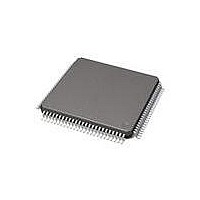71M6513-IGT/F Maxim Integrated Products, 71M6513-IGT/F Datasheet - Page 45

71M6513-IGT/F
Manufacturer Part Number
71M6513-IGT/F
Description
IC ENERGY METER 3PH 100-LQFP
Manufacturer
Maxim Integrated Products
Datasheet
1.71M6513H-IGTF.pdf
(104 pages)
Specifications of 71M6513-IGT/F
Mounting Style
SMD/SMT
Package / Case
LQFP-100
Program Memory Size
64 KB
Program Memory Type
Flash
Supply Current (max)
6.4 mA
Lead Free Status / RoHS Status
Lead free / RoHS Compliant
Available stocks
Company
Part Number
Manufacturer
Quantity
Price
Company:
Part Number:
71M6513-IGT/F
Manufacturer:
MAXIM
Quantity:
1 300
Company:
Part Number:
71M6513-IGT/F
Manufacturer:
Maxim Integrated
Quantity:
10 000
Part Number:
71M6513-IGT/F
Manufacturer:
MAXIM/ç¾ژن؟،
Quantity:
20 000
Internal Clocks and Clock Dividers
All internal clocks are based on the watch crystal frequency (CK32 = 32,768Hz) applied to the XIN and XOUT pins. The PLL
multiplies this frequency by 150 to 4.9152MHz. This frequency is supplied to the ADC, the FIR filter (CKFIR), the clock test
output pin (CKTEST), the CE DRAM and the clock generator. The clock generator provides two clocks, one for the MPU
(CKMPU) and one for the CE (CKCE).
The MPU clock frequency is determined by the I/O RAM register MPU_DIV (0x2004[2:0]) and can be CE*2
where MPU_DIV varies from 0 to 7 (MPU_DIV is 0 on power-up). This makes the MPU clock scalable from 4.9152MHz down
to 38.4kHz.
The circuit also generates a 2x MPU clock for use by the emulator. This clock is not generated when the I/O RAM register
ECK_DIS (0x2005[5]) is asserted by the MPU.
I2C Interface (EEPROM)
A dedicated 2-pin serial interface implements an I2C driver that can be used to communicate with external EEPROM devices.
The interface can be multiplexed onto the DIO pins DIO4 (SCK) and DIO5 (SDA) by setting the I/O RAM register DIO_EEX
(0x2008[4]). The MPU communicates with the interface through two SFR registers: EEDATA (0x9E) and EECTRL (0x9F). If the
MPU wishes to write a byte of data to EEPROM, it places the data in EEDATA and then writes the ‘Transmit’ code to EECTRL.
The write to EECTRL initiates the transmit sequence. By observing the BUSY bit in EECTRL the MPU can determine when the
transmit operation is finished (i.e. when the BUSY bit transitions from 1 to 0). INT5 is also asserted when BUSY falls. The MPU
can then check the RX_ACK bit to see if the EEPROM acknowledged the transmission.
A byte is read by writing the ‘Receive’ command to EECTRL and waiting for BUSY to fall. Upon completion, the received data
will appear in EEDATA.
The serial transmit and receive clock is 78kHz during each transmission, and SCL is held in a high state until the next
transmission. The bits in EECTRL are shown in Table 56.
The EEPROM interface can also be operated by controlling the DIO4 and DIO5 pins directly. However, controlling DIO4 and
DIO5 directly is discouraged, because it may tie up the MPU to the point where it may become too busy to process
interrupts.
A Maxim Integrated Products Brand
© 2005-2011 Teridian Semiconductor Corporation
Figure 11: Voltage Range for V1
V3P3-10mV
400mV
V3P3 -
VBIAS
V3P3
0V
V1
operation,
Battery or
enabled
Normal
mode
WDT
reset
WDT dis-
abled
3-Phase Energy Meter IC
(V1 < VBIAS)
the battery is
enabled
when
71M6513/71M6513H
DATA SHEET
SEPTEMBER 2011
Page: 45 of 104
-
MPU_DIV Hz












